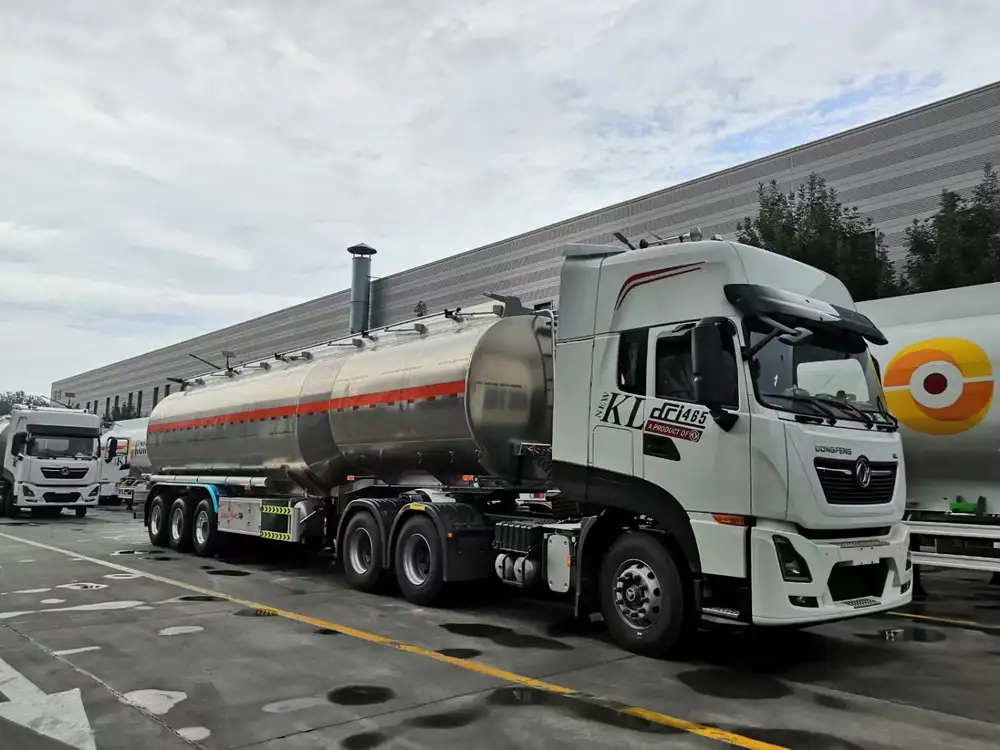In the transportation and logistics industry, semi-tankers play a crucial role in moving liquid bulk products, ranging from fuel to agricultural products and chemicals. Knowing the capacities of these tanks is essential for manufacturers, trucking companies, and logistics managers as it impacts routes, schedules, and operational costs. This article dives deep into how many gallons a semi-tanker holds, examining capacity variations, design types, and influential factors.
1. What is a Semi-Tanker?
A semi-tanker, commonly referred to as a tank truck or tanker trailer, is a specialized vehicle designed to transport liquid substances. These vehicles have two main components: a tractor unit (the semi) and a trailer equipped with a cylindrical tank. Depending on the application, they can carry hazardous materials, food items, and fuel.
Types of Semi-Tankers
- Fuel Tankers: Designed to transport gasoline, diesel, or kerosene.
- Chemical Tankers: Built to handle corrosive or hazardous chemicals.
- Food Grade Tankers: Specifically designed for transporting edible liquids like milk or juices.

2. Semi-Tanker Capacities Explained
The capacity of a semi-tanker can vary significantly depending on the design, type of material being transported, and legal regulations in different regions. In general, semi-tankers can hold from 5,000 to over 11,000 gallons of liquid. The two most common sizes include:
| Tanker Type | Capacity (Gallons) | Common Uses |
|---|---|---|
| Standard Tanker | 6,000 – 10,000 | Fuel, chemicals |
| Specialized Tanker | 10,000 – 11,600 | Food-grade products, hazardous materials |
Factors Influencing Semi-Tanker Capacity
- Tank Design: The shape and structure of the tank itself, including the presence of baffles or dividers inside to minimize sloshing.
- Regulations: DOT (Department of Transportation) regulations limit the maximum capacity for transporting certain materials, especially hazardous substances.
- Material: Tanks made from aluminum vs. stainless steel may have different maximum capacities due to density and weight considerations.
3. The Different Capacities of Semi-Tankers by Use

3.1. Fuel Tankers
Fuel tankers are among the most common types of semi-tankers.
- Typical Capacity: Ranges from 8,000 to 11,000 gallons.
- Design Features: Often segmented to allow for carrying multiple types of fuel in the same trip.
3.2. Chemical Tankers
Chemical tankers are built to transport liquid chemicals and require specialized materials for safety.
- Typical Capacity: Generally between 5,000 and 10,000 gallons depending on the specific chemicals being transported.
- Design Features: Equipped with internal coatings and heating elements to prevent material degradation.
3.3. Food-Grade Tankers
Food-grade tankers are designed under strict regulations to maintain product safety and cleanliness.
- Typical Capacity: Typically around 5,000 to 10,000 gallons.
- Design Features: Often utilize smooth stainless steel and are designed for easy cleaning to meet health standards.

3.4. Industrial Liquid Transport
For bulk liquid transport in the industrial sector, semi-tankers also accommodate larger loads.
- Typical Capacity: Up to 11,600 gallons.
- Design Features: May include multi-chamber designs for transporting mixed materials safely.
4. Calculating Effective Load Capacity
To understand how many gallons a semi-tanker can effectively hold, one must consider its total capacity and the following:
- Weight Restrictions: In the U.S., federal regulations restrict the maximum weight for semi-trucks, including the semi-tanker and load, to 80,000 pounds on interstate highways.
- Liquid Density: The type of liquid affects how many gallons can be transported without exceeding weight limits.
Example Calculation
To illustrate this, let’s consider a fuel tanker with a capacity of 10,000 gallons:
- Assuming gasoline density: ~6.1 pounds per gallon.
- Total weight when fully loaded:
- 10,000 gallons x 6.1 lbs/gallon = 61,000 lbs
- Total weight (including empty tanker around 15,000 lbs) = 76,000 lbs
Since 76,000 pounds falls under the federal limit of 80,000 pounds, this configuration is compliant.

5. The Importance of Knowing Semi-Tanker Capacities
Knowing the capacity of semi-tankers is crucial for several key reasons:
- Cost Efficiency: Understanding how much can be transported in each trip helps logistics companies optimize routes and reduce fuel costs.
- Regulatory Compliance: Staying within legal load limits is necessary to avoid fines and operate safety-focused.
6. Comparison of Cargo Diversities and Capacities
Cargo diversity and its associated challenges play a role in deciding which semi-tanker to use. Here, we present a brief comparison for transporters:
| Cargo Type | Tank Type | Weight Considerations | Capacity Range |
|---|---|---|---|
| Gasoline | Standard Fuel Tank | 6.1 lbs/gallon (max total weight) | 8,000 – 11,000 gallons |
| Milk | Food-Grade Tank | 8.6 lbs/gallon | 5,000 – 9,000 gallons |
| Chemicals | Chemical Tank | Varies widely based on type | 5,000 – 10,000 gallons |
| Water | Standard Tank | 8.34 lbs/gallon | 10,000 – 11,600 gallons |
7. Innovations in Semi-Tanker Design Affecting Capacity
Recent innovations in semi-tanker design are reshaping how gallons are calculated and handled:
- Lightweight Materials: New composites allow tankers to carry more cargo without exceeding weight limits.
- Modular Designs: Tanks designed with adaptable sizes can better fit specific load requirements.
- Smart Technologies: IoT sensors monitor load weight, allowing for real-time adjustments and efficiency.

8. Frequently Asked Questions
8.1. How do I choose the right size semi-tanker for my needs?
Assess your load requirements, regulatory limits, and logistical constraints. Consider whether the nature of the product requires a specialized tank.
8.2. Are all tanks rated the same in terms of pressure tolerance?
No, different materials and designs have varied pressure ratings. Always refer to certification standards when choosing a semi-tanker.

8.3. What additional factors should I consider for operation?
Investigate maintenance, fuel efficiency of the tractor with the semi, and compatibility with transportation routes.
9. Conclusion
Determining how many gallons a semi-tanker holds is not merely a matter of volume; it encompasses a thorough understanding of the vehicle’s design, regulatory frameworks, and the nature of the cargo being transported. Utilizing this knowledge can enhance operational efficiency, comply with regulatory demands, and significantly improve logistics and transportation planning.
Understanding these complexities positions manufacturers, trucking companies, and logistics managers to make informed decisions that can streamline operations and foster cost-effective practices across the board. Whether simply transporting fuel or managing the intricacies of hazardous chemicals, a comprehensive grasp of semi-tanker capacities is indispensable in today’s fluid transportation landscape.



